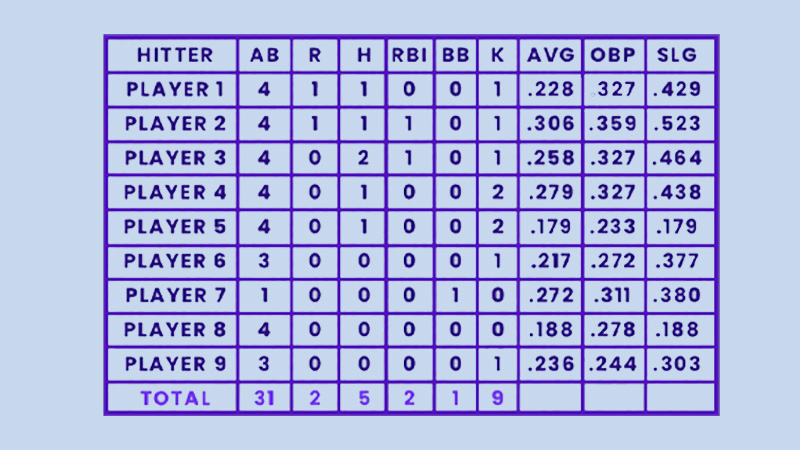In the world of baseball, statistics are an integral part of understanding and evaluating a player’s performance. Among the numerous statistics used to assess a batter’s offensive capabilities, one key metric stands out: Total Bases (TB).
Total Bases provide valuable insights into a batter’s ability to hit for power and advance around the bases. Whether it’s a single, double, triple, or home run, each hit contributes a specific number of Total Bases to a player’s overall tally.
In this guide, we will delve into the definition of Total Bases, explore the breakdown of bases assigned to different types of hits, discuss its importance in evaluating offensive performance, and delve into examples from baseball history.
Read this till the and I promise that you will have a comprehensive understanding of what Total Bases represent and how they contribute to the captivating world of baseball statistics. So, let’s start it.
What are Total Bases (TB)?
In the game of baseball, statistics play a crucial role in evaluating a player’s performance and contribution to the team. One such statistic that holds significance is Total Bases (TB). Total Bases refers to the number of bases a batter gains through his hits.
It provides valuable insights into a player’s offensive production and power-hitting abilities.
Total Bases
Total Bases (TB) is a statistical category in baseball that measures the number of bases earned by a batter through his hits. It serves as an indicator of a batter’s overall offensive output. By calculating the total bases, we can quantify the impact and effectiveness of a batter’s hits.
Breakdown of the Number of Bases Assigned to Each Type of Hit

To comprehend Total Bases, it’s essential to understand the specific number of bases associated with each type of hit:
Single (1 TB)
When a batter hits the ball and reaches first base safely without any errors or fielder’s choice, it is recorded as a single. A single contributes one total base to the batter’s tally.
Double (2 TB)
A double occurs when the batter hits the ball and reaches second base safely without any errors or fielder’s choice. Doubles are typically hit to the outfield or down the lines, allowing the batter to advance to second base. It adds two total bases to the batter’s count.
Triple (3 TB)
A triple is earned when the batter hits the ball and reaches third base safely without any errors or fielder’s choice. Triples often happen when the ball is hit deep into the outfield, giving the batter enough time to run to third base. It contributes three total bases to the batter’s total.
Home Run (4 TB)
The most coveted hit in baseball, a home run, occurs when the batter hits the ball over the outfield fence (fair territory) without any errors or interference.
The batter is then allowed to circle the bases and touch home plate, scoring a run for his team. A home run awards the batter four total bases.
TB as a Measure of Offensive Production
Total Bases play a significant role in evaluating a batter’s offensive production. It provides a quick measure of how well a batter is hitting and how many bases he is advancing in the game.
A higher total base count indicates a more impactful and productive performance at the plate. By considering the total bases, analysts, coaches, and fans can gauge a batter’s power-hitting ability and overall offensive contribution.
Understanding the concept of Total Bases allows us to comprehend the significance of each hit and the cumulative impact it has on a player’s performance.
As we explore further, we will discover how to calculate Total Bases, its relationship with other offensive statistics, and notable examples from baseball history that highlight the importance of this statistic.
Calculation of Total Bases in Baseball

Calculating Total Bases is a straightforward process that involves summing up the total bases earned from each hit a player records in a game, series, or season. Let’s consider an example to understand how Total Bases are calculated.
Suppose a player has the following hits in a game:
- 2 singles (2 total bases)
- 1 double (2 total bases)
- 1 triple (3 total bases)
- 1 home run (4 total bases)
To calculate the player’s Total Bases for that game, we add up the total bases earned from each hit: 2 (singles) + 2 (double) + 3 (triple) + 4 (home run) = 11 Total Bases
Therefore, in this particular game, the player would have accumulated 11 Total Bases.
Summing Up the Total Bases Earned From Each Hit
To calculate Total Bases over a series or season, we apply the same principle of summing up the total bases earned from each hit. By tracking a player’s hits, we can continuously update their Total Bases count to assess their overall offensive production.
For example, if a player has 10 singles (10 total bases), 5 doubles (10 total bases), 2 triples (6 total bases), and 3 home runs (12 total bases) throughout a season, we add up the total bases earned from each hit: 10 (singles) + 10 (doubles) + 6 (triples) + 12 (home runs) = 38 Total Bases for the season
Illustration of How Total Bases Reflect a Batter’s Performance in a Game
Total Bases provide a tangible representation of a batter’s performance within a game. A higher Total Bases count signifies that the batter has been successful in hitting the ball with power and advancing around the bases.
For instance, if a batter records a single, a double, and a triple in a game, it means they have accumulated 6 Total Bases. This indicates a strong offensive performance, as they have hit the ball well and managed to advance to second and third base in addition to reaching first base.
Total Bases and Offensive Performance
Total Bases (TB) play a crucial role in evaluating a batter’s offensive performance. They provide valuable insights into a batter’s hitting ability, power, and overall contribution to the team’s scoring potential.
Using Total Bases to Evaluate a Batter’s Hitting Ability
Total Bases offer a clear measure of a batter’s hitting ability. By accumulating a higher number of Total Bases, a batter demonstrates their effectiveness in hitting the ball with power and advancing around the bases.
Batters who consistently accumulate a significant number of Total Bases are often regarded as potent offensive threats.
Total Bases also help identify a batter’s proficiency in generating extra-base hits, such as doubles, triples, and home runs. Players who excel in these categories are known for their ability to drive in runs and produce scoring opportunities for their team.
Relationship Between Total Bases and Other Offensive Statistics
Batting Average (BA)
Batting Average is a commonly used statistic that measures a batter’s success in getting a hit per at-bat. While Batting Average focuses on the frequency of hits, Total Bases provide a more comprehensive picture of a batter’s offensive impact.
Batters with a higher Total Bases count often have a higher Batting Average, as they accumulate hits that result in advancing multiple bases.
Slugging Percentage (SLG)
Slugging Percentage measures a batter’s ability to hit for extra bases. It is calculated by dividing the total bases by the total number of at-bats. Total Bases are the primary component in calculating Slugging Percentage, making it a vital indicator of a batter’s power hitting.
A higher Total Bases count contributes to a higher Slugging Percentage, signifying a batter’s capability to hit for extra bases consistently.
On-Base Plus Slugging Percentage (OPS):
OPS combines a batter’s on-base percentage (OBP) with their slugging percentage (SLG). It provides a comprehensive measure of a batter’s overall offensive production.
Total Bases significantly contribute to the slugging component of OPS, as they reflect a batter’s ability to generate extra-base hits and hit for power.
Significance of High Total Bases in Relation to Power Hitting
High Total Bases are strongly correlated with power hitting. Batters who consistently accumulate a large number of Total Bases exhibit the ability to hit for extra bases, drive in runs, and generate scoring opportunities.
They possess the power to change the dynamics of a game with one swing of the bat.
In addition, a high Total Bases count indicates a player’s ability to hit the ball with authority and consistently reach base safely. This can put pressure on opposing pitchers, force defensive adjustments, and significantly impact the outcome of a game.
Examples From Baseball History
Total Bases (TB) have played a significant role in baseball history, with numerous players achieving remarkable totals and setting records.
Notable Players With High Total Bases
Throughout baseball history, there have been several legendary players known for accumulating high Total Bases. These players consistently demonstrated their ability to hit for power and generate extra-base hits, leaving a lasting impact on the game. Some notable players include:
- Babe Ruth: Regarded as one of the greatest hitters in baseball history, Babe Ruth recorded exceptionally high Total Bases during his career. His prodigious power and ability to hit home runs contributed significantly to his Total Bases count.
- Hank Aaron: Hank Aaron, known as “Hammerin’ Hank,” amassed an impressive Total Bases tally throughout his career. With his consistent power hitting and ability to hit for both average and power, Aaron ranks among the all-time leaders in Total Bases.
- Barry Bonds: Barry Bonds holds the single-season record for Total Bases, achieving a remarkable total during his record-breaking 2001 season. Bonds’ combination of power and plate discipline resulted in numerous extra-base hits and boosted his Total Bases count.
Records and Milestones Associated With Total Bases
Total Bases have been a focal point for records and milestones in baseball. Some notable achievements include:
- Single-Season Total Bases Record: The single-season Total Bases record is held by Babe Ruth, who set the mark in 1921 with an astounding total. This record has stood for decades, representing the pinnacle of power hitting in a single season.
- Career Total Bases Record: Hank Aaron holds the career Total Bases record, accumulating an incredible number over his illustrious career. Aaron’s consistent offensive production and longevity contributed to this remarkable feat.
Impact of Total Bases on Player Evaluations and Accolades
Total Bases play a significant role in evaluating a player’s offensive prowess and are often considered when determining various accolades and honors. For example:
- Most Valuable Player (MVP) Awards: Total Bases are a crucial factor considered by voters when determining the Most Valuable Player in a league. A player with a high Total Bases count showcases their ability to impact the game offensively, contributing to their candidacy for MVP recognition.
- Hall of Fame Consideration: When evaluating a player’s Hall of Fame candidacy, Total Bases are taken into account as an indicator of offensive excellence and power hitting. Players with substantial Total Bases totals often enhance their chances of earning a place in the prestigious Hall of Fame.
Total Bases serve as a historical benchmark for measuring a player’s offensive contributions and power-hitting abilities.
They exemplify the impact that players can have on the game by consistently hitting for extra bases, driving in runs, and igniting their team’s offense.
The pursuit of high Total Bases counts has shaped baseball history and continues to captivate fans as players strive to leave their mark on the record books.
FAQs
What if a batter reaches base due to an error or fielder’s choice? Does it count toward Total Bases?
No, Total Bases only include hits that result in the batter reaching base safely. If a batter reaches base due to an error or fielder’s choice, it does not contribute to their Total Bases count.
Can a batter accumulate more than four Total Bases in a single plate appearance?
No, a single plate appearance can result in a maximum of four Total Bases. If a batter hits a home run, it automatically awards them four Total Bases, regardless of how many runners are on base.
How do Total Bases account for walks or hit-by-pitches?
Total Bases does not include walks or hit-by-pitches. It only takes into account hits, such as singles, doubles, triples, and home runs. These hits result in the batter advancing bases and contribute to their Total Bases count.
Are Total Bases equally important for all positions in baseball?
Total Bases are generally considered more important for positions traditionally associated with power hitting, such as first basemen, outfielders, and designated hitters. However, Total Bases can still be relevant for all positions as it reflects a batter’s offensive production and ability to generate extra-base hits.
Can a player’s Total Bases be negative?
No, Total Bases cannot be negative. Total Bases are always zero or a positive value, representing the number of bases earned by a batter through hits.
Conclusion
Total Bases (TB) serve as a fundamental statistic in baseball, measuring the number of bases a batter gains through hits. Each type of hit contributes a specific number of Total Bases: singles (1 TB), doubles (2 TB), triples (3 TB), and home runs (4 TB).
As fans, analysts, and coaches, recognizing the importance of Total Bases allows us to appreciate the remarkable achievements of players and their ability to shape the history of the game through their offensive prowess.
So, the next time you’re following a baseball game or analyzing a player’s performance, keep an eye on Total Bases as a key indicator of their offensive productivity and power-hitting skills. Best of luck.







